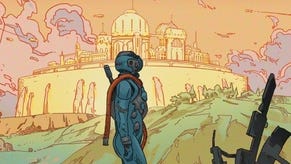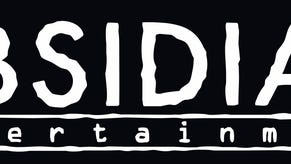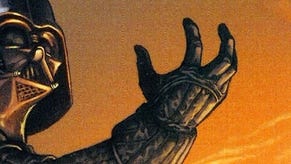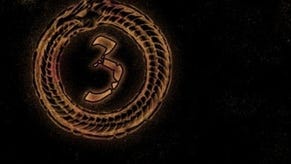Neverwinter Nights 2
Part 2: More time talking to the Obsid-don.
The problem is always time.
You get a certain level of developer with a certain history of games, and there's no end of things you want to talk to them about. We want to try and take apart Feargus Urquhart and his Obsidian team-mates' prehistory at Black Isle (i.e. OMFG!!! Fallout! Planescape! The r0x0rs! What was in Fell-from-Grac3's D1ary!?!!?!). We want to talk about his future - if we were being particularly sneaky, we'd try to get something out of him about the recently announced deal between Obsidian and Sega to "do" an RPG (We do, when the tape stops rolling, and receive a start of horror and a smile that says that a smile's the only comment we're going to get). But no time! No time!
Instead, we stay on the issues closest to Neverwinter Nights: that of how they tie into a pre-existing community and... well, the relatively recent news that NWN 2's Lead Designer, "Ferret" Baudoin, had left the company. However, to try and avoid a straight PR-friendly answer we're going to have to creep up on the issue.
Let's see how it goes.
You've played enough role-playing games to know when you've really enjoyed the first hour, then you realise it's just the same things over and over again. But a moral decision is something you have to think about, based upon the situation and everything. And if we throw things like that in... well, I'm not saying it's like some big stew or something. We want to tell a story. We want it to mean something. To have a theme.... and themes are often moral.
The idea is by tying your moral decision into the general theme. In the case of Planescape Torment, it was "Who you are" and discovery and all that other stuff. Well, it's where you get the sense of it. RPGs are also about the character. In some ways, as graphics have gotten better and the world has gotten more detailed people are separated more from their character. When graphics were less developed in role-playing games - like in Ultima - everything was in your head. What your character was, how powerful they are, what they did and who they were... well, now we have to pull more tools out of the bag to connect to your character, to have them be you. That's what it's about. It's not just that it's you... but it's the "you" in the world in the story, in the game. And the more things which make you feel that way the better, and Moral Decisions are part of that.
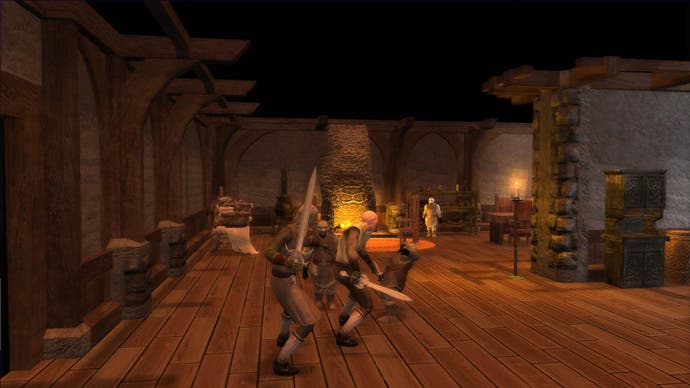
We actually hired two of our scripters [from the community]. That's our term we use for the people who use the scripting language. It's more than that. They help the designers. The designers don't use the scripting language a lot, so the scripters are powerful. They're sort of programmer/designers. Two directly from the mod community. In essence, their demo reels were their mods. Also, anyone we hire we have them do a design test. One of the things we always suggest is to take some of the stuff you do in your design test and actually create it in some kind of toolset. We've had people use Dungeon Siege. It's okay to use - a little complex - but once you know how to use it it's good, but to start with it's daunting. And a couple have been in the Morrowind tool set. But the vast majority have been in the Neverwinter tool set, which told us that how Bioware generated levels was something we shouldn't change. It seemed easy to get in initially and to get stuff going.
I downloaded Goliath. It's a multiplayer title, from the student one. I didn't actually play the official ones. It's pretty interesting. It's a multiplayer thing about a giant robotic thing in the desert, and there are sixteen players in jeeps. The idea is to slow down this Goliath, by activating these refineries by using the fuel trucks to get from A to B. You're trying to slow down Goliath so he doesn't destroy the fuel trucks en route. It's just a different take on the multiplayer thing, working together to stop this thing rather than trying to shoot each other.

Third Quarter.
We decide to do a game. How it works at my level is that I talk to the game designers. As time has gone on, some games we've done have been more successful than other games - at least from a design perspective. My job is trying to define the few goals we want to stay with. For example, Planescape is a good example. Its goals were: we want to make a Planescape game. We have to use the Baldur's Gate engine. Planescape is very much about Sigil, which is interesting... but there are other planes. You also have to go to the different planes. And it needs to be very story-centric. That's the box that I drew, and it's how everything starts. We try to do it like this, but have forty goals. As soon as you have more than three or four or five goals, no-one knows what they're chasing.
It then goes to an expanded version of that. If we break each of the core aims down, and decide what the cool ideas are in each of them? We write a five-page story. The five-page story gets turned into a fifteen-page story. Then we pull out and define all the areas, and the areas turn into 20-page documents, so before you know it, it's gone from three pages to 400. But it's done in a way of continued sub-sets, so it goes from before. So you don't lose the point of it, as you can get lost sometimes.
There are over 110 areas in Neverwinter 2, so if you make areas outside your goals you get lost and then the results end up not feeling like part of the whole. After that, we have a big document which we then proceed with to implementation. Here we tie a designer and a scripter together, who implement the areas. Chris Avellone [Lead Designer on Planescape Torment and founding member of Obsidian - Ed] always takes the big writing task - so for Neverwinter Nights 2, he's written all the companions and all the major characters and proof-reads almost all the dialogue, and fixes it out to make sure it's all uniform. We have these individual teams, then we have these people over them to make sure it all fits together.
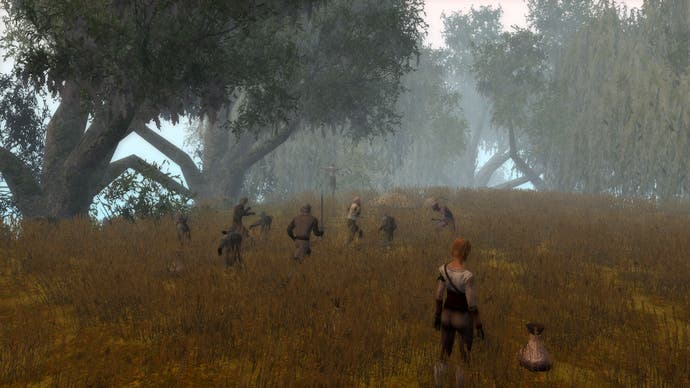
Not to minimise what the lead designer does, but at this point it's all kind of "keeping it rolling" mode. All the design work has been done. All the dialogue has been written. We're in polish and get-it-done mode. What we're lucky about is that also working at Obsidian was JE Sawyer [The New Lead Designer - Ed] who used to work on Black Isle studios with us. He was hired by Interplay to be the web guy on Planescape Torment, before moving to be a designer on Icewind Dale, Icewind Dale II and Baldur's Gate III... before that got cancelled. Or rather, lost the licence which got it cancelled. Josh is a really good closer. He knows how to take all the different things, and talk to all the programmers and designers and scripters and artists and get the game ready to go.
Neverwinter Nights 2 is coming to the PC in the third quarter of 2006, and will be published by Atari.

